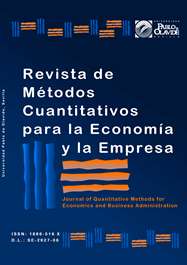Asignación óptima de capital en base al perfil de riesgo de las instituciones de inversión colectiva: una aplicación de las medidas de riesgo distorsionadas
DOI:
https://doi.org/10.46661/revmetodoscuanteconempresa.2221Palabras clave:
Asignación de capital, medidas de riesgo distorsionadas, perfil de riesgo, riesgo agregado, capital allocation, distortion risk measures, risk profile, aggregated riskResumen
Los recientes marcos regulatorios del sector financiero y asegurador otorgan una creciente importancia a la gestión de riesgos. El regulador exige a las entidades que dispongan de un capital reservado para hacer frente a posibles pérdidas derivadas de sus actividades; este capital se cuantifica habitualmente mediante la aplicación de medidas de riesgo. Es esencial para la toma de decisiones de los gestores de estas entidades conocer qué partes de su negocio contribuyen en mayor medida a los requerimientos de capital. Para este fin se aplican técnicas de asignación óptima de capital. En este artículo se utilizan criterios de asignación óptima de capital en el contexto de la gestión de activos con el objetivo de analizar los coeficientes de liquidez de un conjunto de Instituciones de Inversión Colectiva (IIC) gestionadas por una misma Sociedad Gestora de Instituciones de Inversión Colectiva (SGIIC). En este nuevo contexto, el riesgo en el que incurre cada IIC es evaluado a través de un conjunto de medidas de riesgo distorsionadas. Se desarrolla un caso práctico para el que los resultados sugieren que el perfil de riesgo de las inversiones de cada IIC es un criterio que debería ser determinante en el establecimiento de sus respectivos coeficientes de liquidez, evitando de este modo penalizar a las estrategias conservadoras.
Descargas
Citas
Artzner P., Delbaen J., Eber M., Heath D. (1999). Coherent measures of risk. Mathematical Finance, 9, 203–228.
Belles-Sampera, J., Guillén, M., Santolino, M. (2013). Beyond Value-at-Risk: GlueVaR distortion risk measures, Risk Analysis, en prensa.
Buch, A., Dorfleitner, G., Wimmer, M. (2011). Risk capital allocation for RORAC optimization. Journal of Banking and Finance, 35, 3001–3009.
Denault, M. (2001). Coherent allocation of risk capital. Journal of Risk, 4, 7–21.
Denuit, M., Dhaene J., Goovaerts M., Kaas, R. (2005). Acturarial Theory for Dependent Risks. Measures, Orders and Models. Chichester: John Wiley & Sons Ltd.
Dhaene, J., Tsanakas, A., Valdez, E., Vanduffel, S. (2012). Optimal Capital Allocation Principles. Journal of Risk and Insurnace, 79, 1–28.
Filipovic, D. (2009). Term-Structure Models. A Graduate Course. Berlin Heidelberg: Springer.
Hardy, M.R. (2006). An Introduction to Risk Measures for Actuarial Applications. Education and Examination Commitee of the Society of Actuaries, C-25-07.
James, J., Webber, N. (2000). Interest Rate Modelling: Financial Engineering. Chichester: John Wiley & Sons.
Kalkbrener, M. (2005). An axiomatic approach to capital allocation. Mathematical Finance, 15, 425–437.
McNeil, A.J., Frey, R., Embrechts, P. (2005). Quantitative Risk Management. Concepts, Techniques and Tools. Princeton: Princeton University Press.
Tasche, D. (2004). Allocating portfolio economic capital to sub-portfolios, in: A. Dev (ed.), Economic Capital: A Practitioner’s Guide. London: Risk Books, 275–302.
Trigo, E., Moreno, R., de la Peña, J.I., Iturricastillo, I. (2011). Principios de asignación de capital en el ámbito de las entidades bancarias, in: J.M. Feria, E. J. Jiménez and M. Guillén (ed.), Investigaciones en Seguros y Gestión del Riesgo: Riesgo 2011. Madrid: Fundación Mapfre.
van Gulick, G., de Waegenaere, A., Norde, H. (2012). Excess based allocation of risk capital. Insurance: Mathematics and Economics, 50, 26–42.
Wang, S., (1995). Insurance pricing and increased limits ratemaking by proportional hazard transforms. Insurance: Mathematics & Economics, 17, 43–54.
Wang, S., (1996). Premium calculation by transforming the layer premium density. ASTIN Bulletin, 26, 71–92.
Descargas
Publicado
Cómo citar
Número
Sección
Licencia
Derechos de autor 2013 Revista de Métodos Cuantitativos para la Economía y la Empresa

Esta obra está bajo una licencia internacional Creative Commons Atribución-CompartirIgual 4.0.
El envío de un manuscrito a la Revista supone que el trabajo no ha sido publicado anteriormente (excepto en la forma de un abstract o como parte de una tesis), que no está bajo consideración para su publicación en ninguna otra revista o editorial y que, en caso de aceptación, los autores están conforme con la transferencia automática del copyright a la Revista para su publicación y difusión. Los autores retendrán los derechos de autor para usar y compartir su artículo con un uso personal, institucional o con fines docentes; igualmente retiene los derechos de patente, de marca registrada (en caso de que sean aplicables) o derechos morales de autor (incluyendo los datos de investigación).
Los artículos publicados en la Revista están sujetos a la licencia Creative Commons CC-BY-SA de tipo Reconocimiento-CompartirIgual. Se permite el uso comercial de la obra, reconociendo su autoría, y de las posibles obras derivadas, la distribución de las cuales se debe hacer con una licencia igual a la que regula la obra original.
Hasta el volumen 21 se ha estado empleando la versión de licencia CC-BY-SA 3.0 ES y se ha comenzado a usar la versión CC-BY-SA 4.0 desde el volumen 22.










